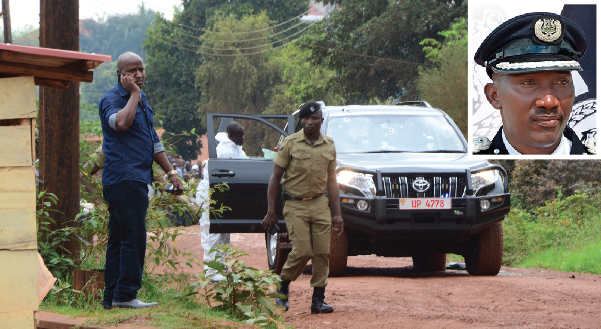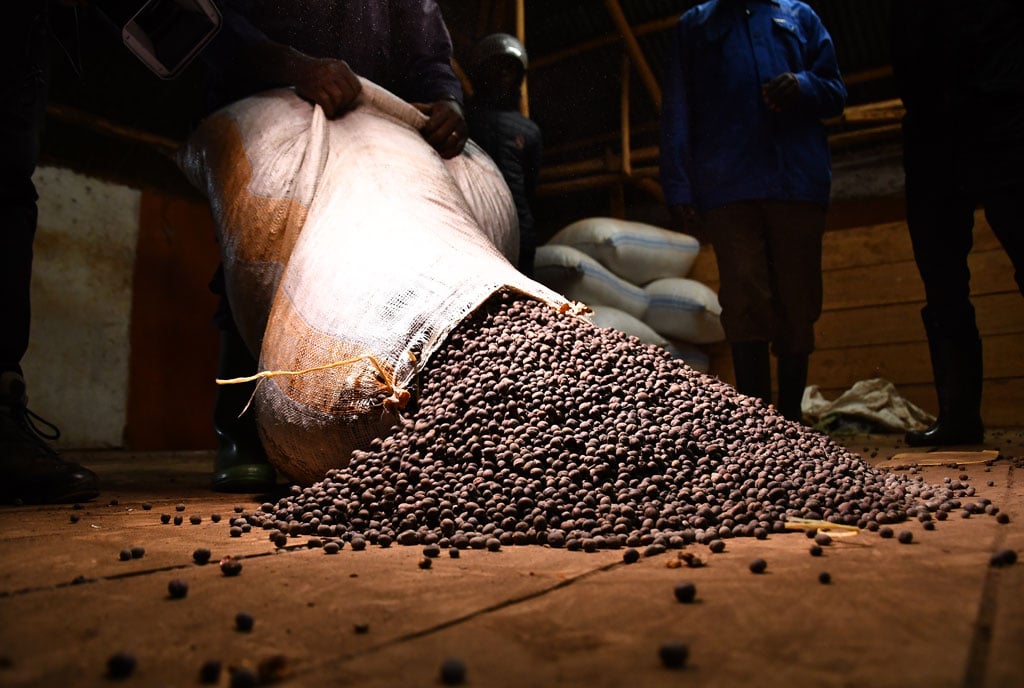Prime
The peculiar patterns in city killings

Police scene-of-crime officers cordon off the spot where former police spokesperson Andrew Felix Kaweesi (inset) was gunned down metres away from his home in Kulambiro, a Kampala suburb on March 17, 2017. PHOTO | FILE
What you need to know:
- Background. The anti-crime infrastructure set up then has also been put to question in Gen Katumba’s shooting as the assassins were seen on CCTV cameras freely operating and making calls before and after the attack.
The attempted assassination of Gen Edward Katumba Wamala has shown how assassins have become bolder, fearless and able to get away with their brutal crimes, at least for now, despite the new anti-crime equipment worth trillions of shilling that government has invested in.
On Friday, during the State of Nation Address, President Museveni confirmed that the gun used in the attack on Gen Katumba last week is the same used in the killing Maj Muhammed Kiggundu in September 2016.
Armed thugs killed Maj Kiggundu alongside his bodyguard in a similar attack.
The government blamed the Allied Democratic Forces (ADF) rebels for the killing.
If it is true the same armed gangs were behind the shootings, Gen Katumba would be the third military personnel to be attacked in Kampala City in a similar style in the last 14 years.
President Museveni said the killers in Gen Katumba’s incident are from the same gang and have been arrested before, but set free by the court.
Unlike in the previous cases where they would hit soft targets, the killers are now focusing on well-guarded people despite heavy investment in anti-crime infrastructure such as CCTV cameras and modern electronic intercepting systems.
The attackers have also changed strategy from attacking crowded areas like markets and bars to targeting individuals, especially defectors or those that lure their recruits to defect.
In the 1990s, the attackers hurled grenades in crowded areas to prove their presence.
For instance, on Valentine Day in 1999, they hurled grenades in an open space of the defunct Telex Bar and nearby grocery.
Four people were killed in the attack and 22 others injured.
Security agencies then blamed ADF rebels for the grenade and petrol bomb attacks, including one in Owino Market (now renamed St Balikuddembe Market).
In 2007, they changed tactics when they started attacking defectors, who had either joined the military or returned to Uganda.
On February 16, 2007, a suspected ADF insurgent hurled a grenade onto a double-cabin pick-up truck in which Lt Issa Lubega, a defector, who was then working with the Joint Anti-Terrorism Taskforce (JATT) , and his brother Moses Mulumba, were travelling at Nateete traffic lights junction at around 8pm
The insurgent escaped on foot into the nooks of Nateete Township, on the outskirts of Kampala City.
Thereafter, President Museveni ordered police to deploy armed guards on all junctions in Kampala City and they have stayed put.
Some of the former ADF rebels were thereafter also given State protection.
But in 2012, former ADF defectors, most of whom had retired into religious affairs, were hunted down one by one and killed.
Sheikh Abdul Karim Sentamu, a religious leader at William Street Mosque in Kampala City, years after he had been released after a prolonged trial on treason charges over allegations of being an ADF rebel, was shot dead on the evening of April 20, 2012.
The shooter jumped onto a getaway motorcycle and fled the scene. Neither the killer weapon nor the shooter have ever been seen again.
On December 28, 2014, Sheikh Mustafa Bahiga, who was Sheikh Sentamu’s co-accused in 1998 in Kasese District, but later released after alleged negotiations, was also shot dead in the evening at Bwebajja Mosque on Entebbe Road.
The killers again used a motorcycle as a gateway means.
Four months later, the killers, using the same style, targeted the prosecutor in the terrorism cases, Joan Kagezi whom they shot dead as she had stopped to buy grocery at Kiwatule in the evening. The killers have never been arrested.
Sheikh Ibrahim Hassan Kirya, the spokesman of the Kibuli-based Muslim leadership, was killed the next year late in the evening of June 30 in Bweyogerere Township, Wakiso District, just four days before President Museveni made his State of the Nation Address.
It was alleged that Sheikh Kirya had previously worked with ADF before he negotiated with the government and returned to Uganda.
The assailant waited when Sheikh Kirya was alone after his bodyguard had retired home.
According to eyewitnesses, the killers shot Sheikh Kirya at close range and then fired several other bullets that killed one other person as he scampered to flee the scene.
Sheikh Kirya’s death and that of others prompted many prominent people to ensure they returned home early and safely.
On November 26, 2016, the shooters changed tactics when they attacked Maj Muhammad Kiggundu, a former commander of ADF, in the morning on a major road.
Maj Kiggundu and his bodyguard, Sgt Steven Mukasa, was driving from home to Kampala City in a Uganda People’s Defence Forces (UPDF) pick-up truck when assailants on a motorcycle fired several bullets at the car.
Maj Kiggundu and Sgt Mukasa were killed instantly.
Security forces arrested a dozen people and prosecuted them, but the court cases fell apart and they were set free.
The assassinations of police spokesman Assistant Inspector General of Police Andrew Felix Kaweesi, and Arua Municipality legislator Ibrahim Abiriga in March 2017 and June 2018 respectively who had no previous connection to the ADF or their prosecution complicated matters.
Both victims were known to be well-guarded and at the time the incidents happened, AIGP Kaweesi had guards, while Col Abiriga was with a military personnel but unarmed.
The anti-crime infrastructure set up then has also been put to question in Gen Katumba’s shooting as the assassins were seen on CCTV cameras freely operating and making calls before and after the attack.
Gen Katumba had previously engaged ADF rebels and coordinated their defection and recruitment into the military. Most of the targeted Muslim sheikhs, who were previously members of ADF, were lured by Gen Katumba to abandon rebellion and return to Uganda.
President Museveni blamed the police for failing to alert patrollers on ground to corner the suspects and also use drones to track them down.
“The criminals will be on continuous viewing by all the camera centres, if these policemen adopt my directives and rationality on the use of those cameras,” he said.




